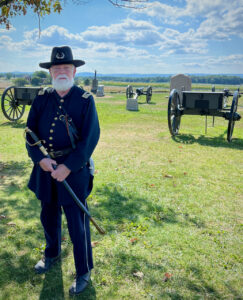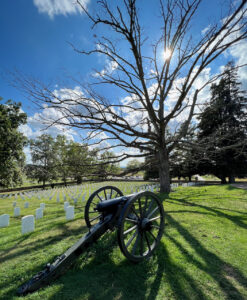
Dan, originally from Ohio, is an “ad hoc volunteer” at Gettysburg National Military Park. Photo by John Griswold, August 26, 2023
Leaving the Flight 93 National Memorial in central Pennsylvania for Gettysburg, a drive of just two-and-a-half hours along Route 30, the old Lincoln Highway, it was tempting to compare the two sites.
Both involved large-scale but very different technological violence; both occurred on otherwise bucolic fields; both were about national determination to different degrees; both are gravesites; both were preserved, but in a sanitized, even beautiful, curated condition; both are managed by the National Park Service; both bring benefit to their local economies. On the one day I stopped at both, some visitors were intense in their professed emotions, but nearly all found the sun too hot and bugs too annoying to walk out on the landscapes of sacrifice to which they were paying homage.
I entered the town of Gettysburg from the west, through battlefields marked with picket fences, cannon, and statues. The town was crawling with tourists. I drove on into the fields east and south—the battle raged and ranged all around the town for three days in July 1863—and finally parked in a tiny gravel lot with no other cars before it got too late. I was losing light. The scope of the battle landscape is overwhelming—it was the Civil War’s deadliest battle—and it was clear I could spend a week walking it.
With the greed of the traveler, I hoped I had chosen a particularly significant location, but there were no other cars there, despite a porta-potty in the lot, and no other visitors to be seen as I climbed a 40-foot hill of manicured battlefield. I thought I had probably chosen poorly.
Still, the stone obelisk at the bottom of the hill was dedicated to the 93d New York Infantry, Headquarter Guard of the Army of the Potomac, and halfway up, a statue of a cavalryman was dedicated to the 2d Pennsylvania Cavalry, which was attached then to the Provost Guard of Army Headquarters. Near the top of the hill was a statue of Major General George Meade on his brass horse. Meade at the time was famously the Commander of the Army of the Potomac, the main Union army in the Eastern Theater of the Civil War.
All these were good signs, if I was going to get the most bang for my buck, so to speak, but the emptiness of the place made me wonder if I was even allowed on this part of the battlefield.
Then, just past Meade, I topped the hill and saw dozens of cars lined up, nose-to-tail, along the blacktop road on the ridgeline, their occupants sitting in air-conditioning, listening to purchased audio tours. (“Fascinating stories…Freedom of Travel…Award-winning platform…Worth every penny!!!!,” $9.99 to $99.99 per car)
I had emerged on Cemetery Ridge at The Angle, symbolically one of the most important sites of the war, the place called “the high-water mark of the Confederacy,” where Pickett’s Charge was repulsed and 42% of the Confederate soldiers in the attack were killed, wounded, or captured. (I had, in an odd coincidence, written something here on that subject before.) It was aturning point in the war.
Next to the road, sitting on a folding chair under a shade tree near the monument to the tactically-important “fire Zouaves” of the 72nd Pennsylvania Infantry, I found a man named Dan dressed as a Staff Officer, a captain, in the Union army. Dan’s actual great-great-great-great grandfather, a proofreader for the Government Printing Office, met Lincoln at a soirée in Washington in March 1864, Dan thinks, four months after Lincoln’s Gettysburg Address.
I asked Dan if he was a Park Service interpretive ranger, and he said no, an “ad hoc volunteer.” I laughed and asked if that meant he snuck onto the battlefield each morning, dressed as a Union officer, and he laughed and said volunteers are part of the NPS system.
“I just try to be respectful of the park and be as authentic [and knowledgeable] as I possibly can,” he said. “Last night I was boning up on my history; it’s a constant process. I’ve been a lover of history my entire life.” He told me about his uniform and gear, explained a few of the monuments around us, and pointed the way to the National Cemetery down the ridge.

Commemorative to the Gettysburg Address, actually given from a platform a short distance away, on the border with the adjacent, private Evergreen Cemetery. Photo by John Griswold
The Gettysburg National Cemetery holds about 6,000 interments, a little more than half from the Civil War. A semi-circular monument commemorates Lincoln’s speech four-and-a-half months after the battle. Battlefield dead were being reburied, next to other men still dying from grave wounds, when Lincoln gave it.
Lincoln himself was very ill with what was apparently smallpox, but his speech of only two minutes is still seen as nearly perfect oratory in service to sacrifice on fields such as these, which tested whether—and perhaps more importantly, in what form—the nation could endure.

Photo by John Griswold
